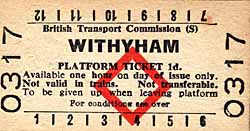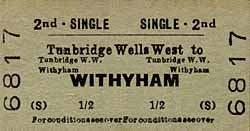|
BRIEF HISTORY OF
THE THREE BRIDGES - TUNBRIDGE WELLS WEST RAILWAY
Following a public meeting in 1852, the East Grinstead Railway
Company was in formed and in November of that year applied to
parliament for powers to construct a 6 3/4 mile branch line from
a terminus at East Grinstead to a junction with the London Brighton
& South Coast Railway's main line at Three Bridges. The bill
received Royal Assent on 8th July 1853 and the branch line opened
on 9th July 1855 with a single intermediate station at Rowfant;
a second station at Grange Road was added in March 1860.
The new line was an immediate success carrying both
passengers and goods. Even before the line opened there was talk
of an extension to Tunbridge Wells and the East Grinstead Groombridge
and Tunbridge Wells Railway Act was passed on 7th August 1862.
Prior to this date the Brighton, Uckfield and Tunbridge Wells
Railway had their Act passed in 1861 for an extension from the
existing terminus at Uckfield to a new terminus at Tunbridge Wells
and work on this line had already started in April 1862.
The EGG & TWR proposed to obtain powers to run over the BU
& TWR line between Groombridge and Tunbridge Wells but before
either line was opened the two companies were absorbed into the
London Brighton & South Coast Railway in January 1865.
 |
The extension to Tunbridge Wells
was opened on 1st October 1866, nearly two years before
the, line from Uckfield was ready; it was single throughout
except for a resited East Grinstead Station and at Groombridge
There were three intermediate stations at Forest Row, Hartfield
and Withyham. |
Despite the success of the original line to East
Grinstead, the extension proved less popular and the initial passenger
service of 6 trains each way per day was soon reduced to save
money, the goods service was however more profitable.
The extension from Uckfield to Groombridge was opened
on 3rd August 1868 and on 1st February 1876 a short spur through
Grove Tunnel was opened between the LBSC terminus and Tunbridge
Wells to a junction with the South Eastern Railway south of their
own station in the town to allow the running of through trains.
On 5th April 1880 the LBSC extended their line from Hailsham to
a junction with the Uckfield line at Eridge with services running
on into Tunbridge Wells.
With the opening of the Lewes & East Grinstead
Railway and the Croydon, Oxted and East Grinstead Railway in 1883
it was once again necessary to resite East Grinstead Station.
The two new lines approached the Three Bridges line at right angles
from the north and south respectively. Because of the angle it
was impossible to take the L & GR into the existing station
so a new station was built quarter of a mile to the west with
two island platforms on the old line above and at right angles
to a new station at the end on junction between the EGR and the
CO & EGR with a sharply curving spur linking the two lines.
The final line in the equation was the Oxted and
Groombridge Railway which opened on 1st October 1888 bringing
yet another service into Tunbridge Wells.
The opening of these new routes from London all
reduced passenger numbers on the line from Three Bridges which
was now the longest out of four routes from London to Tunbridge
Wells. Only one intermediate station, Forest Row was able to build
up quite respectable commuter traffic to London with several trains
terminating there.
| With ever rising operating costs
a new rail motor service consisting of a single carriage hauled
or propelled by a small tank engine was introduced in 1906.
A new halt was opened at High Rocks between Groombridge and
Tunbridge Wells, served only by the rail motors. The new trains
eventually halted the decline in revenue with the service
reaching its peak in 1914. |
 |
With ever rising operating costs a new rail motor
service consisting of a single carriage hauled or propelled by
a small tank engine was introduced in 1906. A new halt was opened
at High Rocks between Groombridge and Tunbridge Wells, served
only by the rail motors. These new trains eventually halted the
decline in passenger revenue with the service reaching its peak
in 1914.
WW1 had little affect on the line and some new services
were introduced following the formation of the Southern Railway
in 1923. WW2 brought a reduction in services with the withdrawal
of the rail motors. A government oil store was established at
Rowfant bringing an increase in freight traffic. After the war
some passenger services were reinstated but by 1950 both passenger
and freight service were in decline and BR was considering the
possible closure of the line between Three Bridges and Ashurst
Junction in 1951 with passenger numbers at Hartfield in 1949 being
only a quarter of those carried in 1923.
The East Grinstead - Lewes line closed in May 1955
but the Three Bridges line survived with a new timetable being
introduced in June 1955. There was a marked improvement in passenger
numbers, especially between Three Bridges and East Grinstead but
despite a proposal to introduce diesel-electric train in 1962
the line was threatened by the Beeching Axe (Dr. Beeching lived
in East Grinstead) when the Three bridges - Tunbridge Wells line
was one of many proposed for closure in March 1963. (The only
line to remain open was the line from London - East Grinstead
via Oxted on which Dr. Beeching was a first class season ticket
holder!)
 |
Despite strong local objections and a new timetable,
Barbara Castle confirmed closure of the line between Three
Bridges and Groombridge from 1st January 1967. Although originally
proposed for closure the section between Groombridge and Tunbridge
Wells West (West was added to the name in 1923) remained open. |
Track lifting began at the east end of the line
late in 1967 and was not completed until 1970. In July 1979 much
of the trackbed between Three Bridges and East Grinstead was turned
into a public footpath and cycleway known as Worth
Way. The 9 1/2 mile section of line between East Grinstead
and Groombridge has also been converted into a public footpath
and cycleway known as Forest
Way.
Although the route into Tunbridge Wells West remained
open there was no investment in the line and by the early 1980's
the track and signaling needed replacing. With the planned removal
of Grove Junction during the upgrade of the Tonbridge - Hastings
line British Rail decided they could no longer justify keeping
the line open and announced closure of the line from 16th May
1983. Once again there were strong objections but these were outweighed
by British Rail's cost argument. They estimated that to upgrade
the infrastructure, while retaining the existing services, would
give a £175,000 loss per year and the Secretary of State
confirmed closure of the line on 6th July 1985.
Grove Junction was removed the day after closure
but the line from Eridge to Tunbridge Wells remained in use until
10th August 1985 when the depot was closed.
Shortly after closure the Tunbridge Wells and Eridge
Railway Preservation Society was formed with an aim of reinstating
the passenger service on the line. The Society acquired the line
in the early 1990's and by winter 1996 they had refurbished half
a mile of track and were able to run a steam service from their
base on part of the old Tunbridge Wells West station site. TWERPS
later merged with the North Downs Steam Railway at Dartford, Kent.
The line is now known as The
Spa Valley Railways, a name chosen as the result of a competition.
The
Spa Valley Railways now runs for 3 1/2 miles to a new station
at Groombridge with an intermediate station at High Rocks built
by the owner of the High Rocks Inn and Restaurant.
Further reading: Three Bridges to Tunbridge Wells
by David Gould Oakwood Press 1983
ISBN 0 85361 299 4
Branch
lines to East Grinstead by Vic Mitchell & Keith Smith
- Middleton Press 1984
ISBN ISBN 090652007X
To see the other stations on the
Three Bridges - Tunbridge Wells West line click on the station
name: Three Bridges,
Rowfant,
Grange Road, East
Grinstead High Level, Forest
Row, Hartfield,
Groombridge, High
Rocks Halt & Tunbridge
Wells West
|




 Home Page
Home Page 



